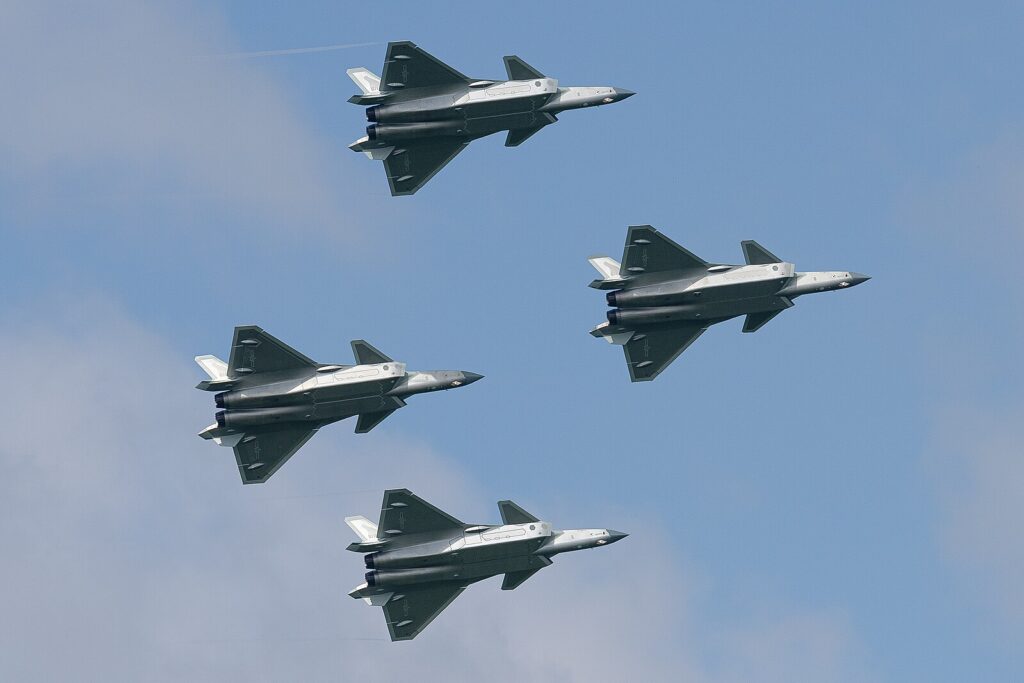The Air Force’s plan to turn a Boeing 747 into an airborne aircraft carrier
- By We Are the Mighty
Share This Article

This article by Ian D’Costa was originally published by We Are the Mighty
We’ve all see the Avengers movie featuring SHIELD’s massive flying aircraft carrier — you know, the one with the gigantic fans and stealth cloaking?
But what you may not know is that the concept of an actual flying carrier isn’t really anything new, and the US military has investigated it time and time again throughout its history. The most recent proposal for such a vehicle came in the form of a highly modified Boeing 747 called the Airborne Aircraft Carrier.

While oceangoing aircraft carriers can bring their complements of fighter and attack aircraft quite literally anywhere around the seven seas, areas deeper inland are far less accessible and sometimes require the use of larger numbers of support assets like refueling tankers, which aren’t always available for a variety of reasons.
The AAC concept tried to solve that problem by using a larger aircraft to fly smaller aircraft above or near deployment zones, where it would release its fighters to carry out their missions.

In the 1930s, the US Navy first began exploring the idea of an airborne carrier by outfitting two dirigible airships, the USS Akron and the USS Macon, with a trapeze mechanism for recovering and launching small propeller fighter planes, along with an internal hangar for storage.
Both the Akron and Macon were lost in storms that decade, but not before they were able to successfully demonstrate that with enough practice and patience, aircraft could be deployed from airbases in the sky.
The onset of World War II made the Navy forget about this idea. But during the Cold War, the notion of having an airborne carrier was resurrected — this time by the Air Force.
At first, the Fighter Conveyor project attempted to put a Republic F-84 “parasite” fighter in the belly of a B-36 Peacemaker nuclear bomber, launched in-flight for reconnaissance operations. The creation of the U-2 Dragon Lady spy plane made the FICON project a moot point, sending it to the graveyard after four years of testing.

Later on, famed defense contractor Lockheed proposed a gigantic nuclear-powered flying mothership with a crew of over 850 and an aerial endurance of 40+ days. The Air Force, by 1973, decided to go a slightly more conventional route instead.
At the time, the Boeing 747 was easily the largest civilian aircraft in the world, serving as a long-range passenger airliner and a cargo transport for a number of freight companies. It wasn’t wholly unreasonable to suggest that such an aircraft could be converted for use as an airborne carrier, fielding a small group of aircraft inside its cavernous interior.
The Air Force’s Flight Dynamics Laboratory, based out of Wright-Patterson AFB, was put on the case to determine the feasibility of such an experiment.

The AAC project called for a Boeing 747-200 to be hollowed out and refitted with a two-level internal hangar that would hold “micro fighters”, small short-range fighter aircraft that could fight air-to-air and air-to-ground sorties after being dropped out of the underside of the jumbo jet. Should the fighters need an extension on their range, the AAC mothership could refuel them as needed from a rotating boom on its rear. Upon concluding their sorties, the micro fighters would simply fly underneath the AAC and be picked up by a mechanism, bringing them back into the hangar.
The AAC would also contain storage for extra fuel, spares and parts, as well as a magazine for missiles and bombs for the microfighters. In addition, sleeping quarters for the crew and pilots, and a small crew lounge for breaks in-between missions was also to be part of the hypothetical flying carrier.
All in all, the concept seemed to be absolutely doable and certainly something the Air Force seemed interested in pursuing, given that the report also projected that conventional Navy aircraft carriers would apparently be obsolete by the year 2000.

However, the project was stalled when research into the design and development of the AAC’s necessary microfighters went nowhere. An airborne warning and control version of the AAC was also proposed, replete with a pair of reconnaissance micro aircraft for surveillance missions; this was also shot down.
Eventually, the Air Force shelved the concept altogether not long after the Flight Dynamics Laboratory claimed it was possible.
While the US military hasn’t done much, if anything at all, to investigate flying aircraft carriers in the four and a half decades since, this seems to be an idea that just won’t go away. Maybe, just maybe, we might see these bizarre vehicles in the not-so-distant future, as technology advances and mission types evolve!
Related Posts
Sandboxx News Merch
-

‘AirPower’ Classic Hoodie
$46.00 – $48.00 Select options This product has multiple variants. The options may be chosen on the product page -

‘Sandboxx News’ Trucker Cap
$27.00 Select options This product has multiple variants. The options may be chosen on the product page -

‘Kinetic Diplomacy’ Bumper Sticker (Black)
$8.00 Add to cart
We Are the Mighty
Related to: Military History

The US Navy is forced to wait on its new flagship frigate

Apophis: Are we prepared to defeat Earth’s greatest planetary threat?

Do sailors have a future in the US Navy? No, according to former Army general

China could stop US airpower from achieving air superiority in the first island chain, top commander says
Sandboxx News
-

‘Sandboxx News’ Trucker Cap
$27.00 Select options This product has multiple variants. The options may be chosen on the product page -

‘AirPower’ Classic Hoodie
$46.00 – $48.00 Select options This product has multiple variants. The options may be chosen on the product page -

‘AirPower’ Golf Rope Hat
$31.00 Select options This product has multiple variants. The options may be chosen on the product page -

‘Sandboxx News’ Dad Hat
$27.00 Select options This product has multiple variants. The options may be chosen on the product page
